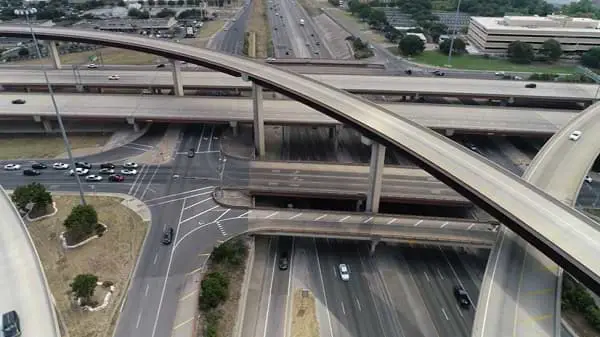
You might be wanting to fly your drone over a road or highway so you get a unique type of shot, but are you legally allowed to fly over moving traffic?
According to the FAA ( Federal Aviation Administration), you cannot fly a small UAS (Unmanned Aerial System) over moving traffic because of two reasons. The drone flight could potentially distract drivers, which may result in an accident, and vehicles move at high speeds, which may cause substantial damage if a drone were to collide with a vehicle.
Keep reading to find out why you can’t use a drone over highways and how you can legally fly your drone over cities.
Why Can’t You Use a Drone Over Highways?
You might be wondering why drone pilots are not allowed to fly drones over roads and highways?
Well, drones are flying machinery and therefore have faults. Anything can happen from machine error to human error. Anything can cause a drone to come crashing down to the ground!
This is the main reason why enthusiasts are not allowed to fly drones over freeways. If the drone had to come plummeting down and hit a car, the impact from the combined velocity of the two objects hitting each other would be massive.
This collision between the drone and moving vehicle would cause a huge accident possibly involving other vehicles as well. If a drone were to come falling out of the sky, drivers will not be aware of the presence of the drone in the first place, and won’t be prepared to avoid the falling drone safely.
The FAA still allows for pilots to fly over stationary vehicles regardless of whether or not there are people in the car, as it believes that there will be a fair amount of protection from a falling drone if something were to go wrong.
However, the rule doesn’t apply to vehicles on the move, because the response time of the driver would be different, and the results of the impact would be more significant.
Even though there is a lot of debate over flying on highways and roads with a drone, it is not allowed, but there are ways you can fly over a road or street as an enthusiast legally and safely.
Keep reading to find out how to fly your drone legally so you stay out of trouble!
How To Fly Over Roads Legally?
In the times we are living in there are roads everywhere and it isn’t as easy to just drive into the countryside every time you are looking for some drone footage.
Sometimes the best footage is right in your home city, during your daily commute, or on your way to the store!
Roads and buildings can make for some beautiful scenery to capture, but how do you do this without breaking any FAA drone rules and regulations?
Here are a few ways to fly over roads that are perfectly legal:
Fly straight up and straight down. In the location, you parked your car or wherever you took off with your drone. You need to fly your drone straight up, as this ensures that the drone is never directly over the road.
However, the camera angle you choose, and the perspective will make it seem as if you are flying over the highway and give it the same effect.
Can You Use a Drone From a Moving Vehicle?
Flying a drone from a moving vehicle has many challenges and if you are not a seasoned veteran then I suggest you don’t do it because it will only end in tears.
Recreational drone pilots are not permitted to fly a drone from a moving vehicle according to the FAAs drone rules and regulations. However, if you are a commercial pilot and under the FAAs part 107 rules, this rule is slightly different for you.
The FAA Part 107 rules state that No Person may operate a small unmanned aircraft from:
- A moving aircraft
- A moving land vehicle
- A water-borne vehicle
Unless the small unmanned aircraft is flown over a sparsely populated area and is not transporting another person’s property.
So, yes, you can fly from a car or other vehicles, if you are operating under part 107, however, the area you are driving in while flying can only be sparsely populated.
If you want to fly your drone while in a moving vehicle, in a densely populated area, then you need to apply for a Part 107 waiver. But the chances of getting this specific type of waiver are very slim and many pilots don’t get them.
One important thing to remember about flying from a moving vehicle is that even though you might be allowed to fly from a moving vehicle, you are still not allowed to fly over moving vehicles, which makes it a lot harder.
Tips On How To Fly a Drone in The City Legally, And Safely
Flying a drone in a city can be tricky because they are densely populated areas with lots of people and roads, which means moving vehicles.
But, you are allowed to fly in a city as long as you are mindful of your surroundings, and pay close attention, as well as follow all the FAA drone rules and regulations when you fly.
Here are the steps to follow in order to fly safely, and legally in a city:
Check Weather Conditions. The first thing you need to do before you even think of flying your drone is to check the weather conditions in the area to determine whether it is safe or not to fly in the area. Flying in bad weather conditions could cause you to lose control of the drone, and it could crash land on the road below or on the street.
Check AirMap. It is very important to check your drone mapping application before you fly. Since cities are densely populated, there is bound to be an airport or two in the area.
To make sure that you are flying safely, it is best to report what you are doing using the LAANC system(Low Altitude Authorization and Notification Capability).
Using this system, you can notify the airport that you are planning a flight in the area. You don’t need to do this only if you are in the airport zone, but also if you are on the edge, just in case you wander into the restricted airspace.
Preflight Checklist. Before you take off, make sure that you, and anyone who might be helping you with the flight, conduct a preflight checklist. This includes checking your drone before the flight to make sure that it is ready to be flown. The preflight checklist usually involves checking the drones batteries, propellers, and other parts of the drone.
Insurance. Another thing I would recommend that you do is that you get insurance for your flight. There are insurance applications that specifically deal with drone pilots and insuring their flights.
You can receive coverage of up to five million dollars on a flight, just by paying only 10-15 dollars! You can download apps like Verifly just as an extra layer of security in case something goes wrong during your flight.
Return to home. When you are going to take off, you need to do one very important thing. Set your return to home higher than the buildings in the area. Why?
Well, this function is very smart, but because the drone is flying automatically at this point, it can fly into a building on its way back to you, and this has happened to many pilots before (not an ideal end to your flight)!
This is why it is important to set the return to home higher than the buildings in the area.
Plan a Rooftop Route. Planning a rooftop route when flying helps you keep away from any roads that might have moving vehicles on them. The only vehicles that would be underneath you, would be stationary vehicles which are ok to fly over.
